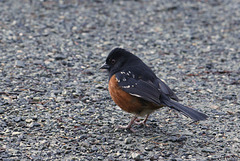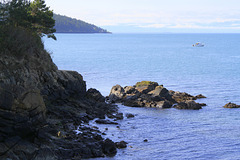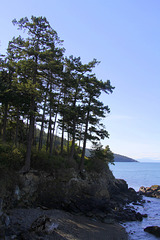RHH's photos with the keyword: washington park
Spotted Towhee
| 05 Sep 2018 |
|
|
This is a Spotted Towhee photographed in Washington Park in Anacortes, Washington.
Spotted Towhee
| 05 Sep 2018 |
|
|
|
Taken in Washington Park near Anacortes, Washington, this is the Spotted Towhee. I sat for an hour and watched some of them and some Fox Sparrows one morning while in the park.
Spotted Towhee
| 05 Sep 2018 |
|
|
This is the Spotted Towhee, now separated from the eastern Towhee, both once known together as the Rufous-sided Towhee.
Spotted Towhee
| 05 Sep 2018 |
|
|
|
I learned this bird as the Rufous-sided Towhee, but the western variety of the species is now known as the Spotted Towhee. He (or she) was photographed in Washington Park near Anacortes, Washington.
Columbia Blacktail Deer
| 05 Mar 2018 |
|
|
|
The Columbia Blacktail Deer is a subspecies of Mule Deer, smaller than an ordinary Mulie and smaller, too, than a Whitetail Deer. It is the only deer west of the Cascades. There are so many of them where we live that they become pests. This photo was taken near Anacortes, Washington, in Washington Park.
Camas
| 02 Feb 2018 |
|
|
|
Camassia quamash was second only to salmon as a food source among the native Indian tribes of the northwest. In many cases families had their own areas which were handed down from generation to generation, and the bulbs, the edible part of the plant, were very carefully harvested with only the largest bulbs being taken. These flower buds were photographed in Washington Park near Anacortes, Washington.
Common Camas
| 30 Apr 2015 |
|
|
|
The Common Camas, Camassia quamash, was an important food source for the native Americans who dug the bulbs in the autumn, roasted or boiled them and sometimes ground them up for flour. These were photographed in Washington Park on Fidalgo Island, where they are common, but there are other areas where they cover whole meadows.
Western Spotted Coralroot
| 27 Apr 2015 |
|
|
|
This was the second orchid of the new season, the Western Spotted Coralroot, Corallorhiza maculata var. occidentalis, another leafless orchid without chlorophyll that depends for its nourishment on a complex relationship with a soil fungus. This example was photographed in Washington Park on Fidalgo Island, but it is a common orchid even at higher elevations.
More Fairy Slippers
| 15 Apr 2015 |
|
|
|
Taken in Washington Park on a rainy day, this little clump of Fairy Slippers was the nicest group I found. The patterned leaves to the right and left, however, are not the leaves of the Fairy Slippers but of the Oregon Fawn Lily, Erythronium oreganum.
Columbia Black-tailed Deer
| 14 Apr 2015 |
|
|
|
Very common around these parts, these deer often become pests. The Columbia Black-tailed Deer is considered a subspecies of the Mule Deer. This deer was photographed in Washington Park on Fidalgo Island.
Henderson's Shooting Star
| 11 Apr 2015 |
|
|
|
This is, I believe, Henderson's Shooting Star, Dodecatheon hendersonii, photographed in Washington Park on Fidalgo Island where it blooms profusely near the seaside.
Oregon Fawn Lily
| 08 Apr 2015 |
|
|
|
Erythronium oreganum grows in abundance in several of the coastal park on Fidalgo Island and we make a point of going to see them every spring. This one was photographed in Washington Park near Anacortes, Washington, on what was obviously a wet day.
On another note, we will be away for several days, first in the Olympic Mountains and then in eastern Washington. Commenting and posting may be delayed or sporadic, so please be patient and I'll eventually catch everyone up again. We'll be home again next week Tuesday.
Corallorhiza maculata var. occidentalis
| 21 May 2014 |
|
|
|
I've posted several pictures of Coralroots recently and thought I'd post a picture showing how they grow. These are the Western Spotted Coralroot growing in a nice clump in Washington Park near Anacortes. Notice the lack of leaves (they are leafless) and they are without chlorophyll too.
This will be my last post for a couple of days. I am leaving shortly on a camping trip with a group of 6-8th graders (I'm one of the chaperones) and will catch everyone up with commenting when I return. Until then, may you all have a good day and a good rest of the week.
Washington Park
| 18 Apr 2014 |
|
|
|
Washington Park is on Fidalgo Island near Anacortes and is actually a city park, though undeveloped except for a campground and picnic area. There is a one-way road that runs around the perimeter of the park, but which is used as much by walkers as by cars. This is that road on the north side of the park near Green Point.
Green Point, Washington Park
| 16 Apr 2014 |
|
|
|
Another shot from Green Point in Washington Park. Just visible on the horizon and mostly hidden by clouds are the Olympic Mountains. This was taken early in the morning as we walked the road through the park.
Green Point, Washington Park
| 14 Apr 2014 |
|
|
|
Taken in Washington Park from the northern end of the peninsula and an open area called Green Point. This looks south through the Straits of San Juan de Fuca. This is a city park but not in the sense suggested by the word "park." It is an area of natural beauty which, though heavily used is still a wonderful spot for wildflowers, native trees and great views of the straits.
Prairie Star
| 11 Apr 2014 |
|
|
|
A rather common spring wildflower in our area, Lithophragma parviflorum, as the name suggests, likes open well-drained areas and is found in Washington Park, where this was photographed, on rocky balds. The flowers are actually pink, but often such a pale pink that they appear white.
Death Camas
| 29 Apr 2011 |
|
|
This is Zigadenus venenosus, the Meadow Death Camas, so called because all parts of the plant are poisonous. It is said that members of the Lewis and Clark expedition became ill from eating the bulbs of this plant after confusing it with other edible Camas bulbs.
Because it is often found in open grazing areas, it is a danger to cattle, sheep and horses, though pigs are supposed to be immune to it. It contains a toxic alkaloid, zygadenine, and can cause vomiting, decrease in blood pressure, seizure, coma and death.
These plants were photographed on rocky sunny southern slopes of Washington Park on Fidalgo Island, where they were just beginning to open. I can grow to about 18 inches, but the plants we saw were much shorter. Needless to say, we did not sample them.
Jump to top
RSS feed- RHH's latest photos with "washington park" - Photos
- ipernity © 2007-2025
- Help & Contact
|
Club news
|
About ipernity
|
History |
ipernity Club & Prices |
Guide of good conduct
Donate | Group guidelines | Privacy policy | Terms of use | Statutes | In memoria -
Facebook
Twitter


















